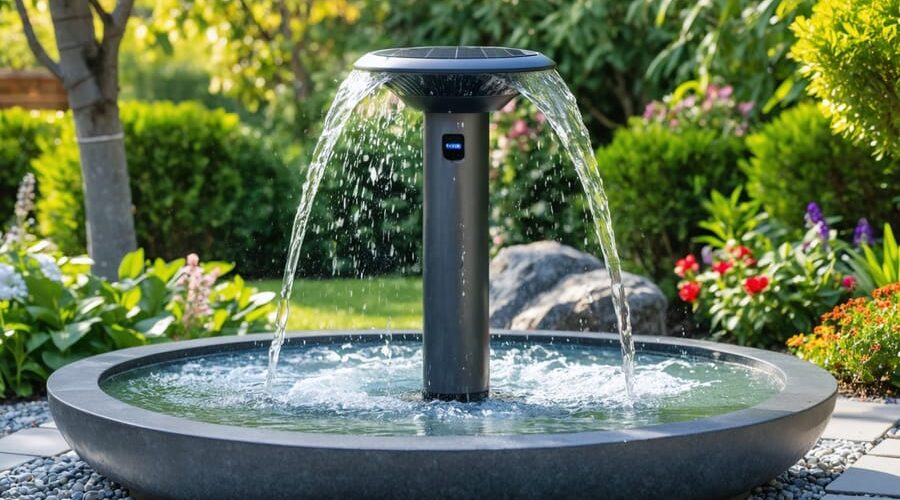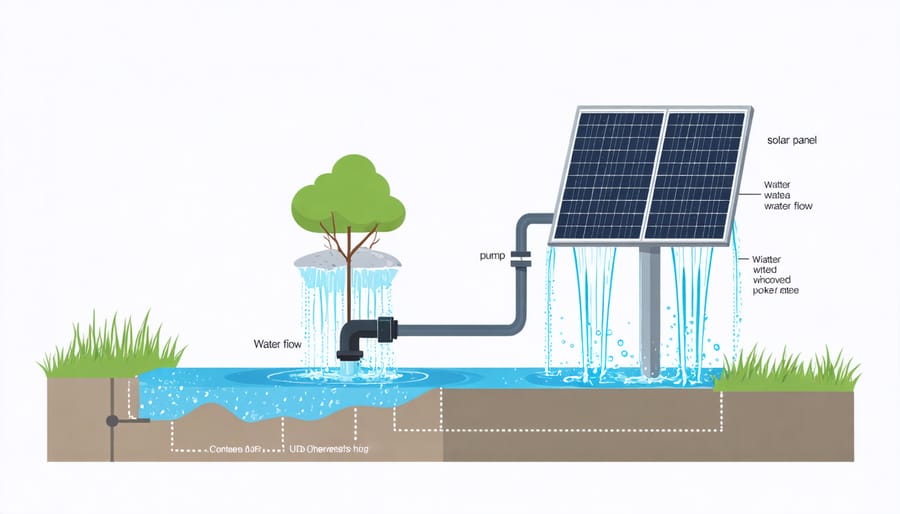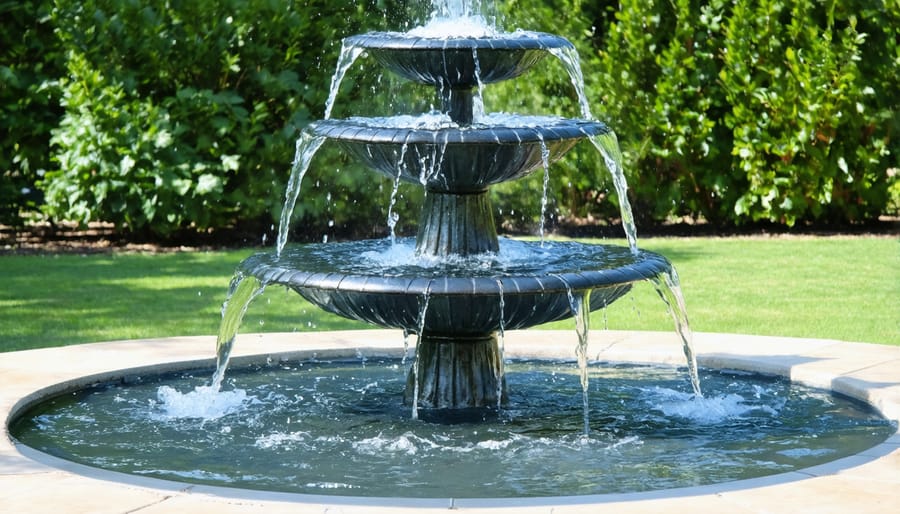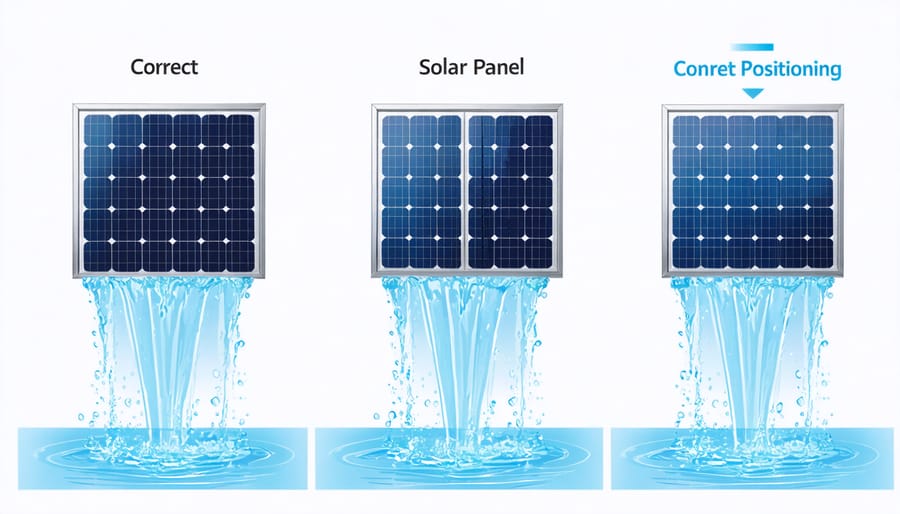
Transform Your Garden with These Beautiful Solar Water Features (That Actually Work)
Transform your outdoor space into a tranquil oasis with the gentle sounds of flowing water, powered entirely by the sun’s energy. Solar-powered water features represent the perfect fusion of sustainable technology and natural beauty, offering an eco-friendly solution to create stunning water displays without increasing your energy bills. These innovative systems capture solar energy through photovoltaic panels, converting it directly into the power needed to circulate water through fountains, cascades, or decorative features.
Whether you’re looking to enhance your garden’s ambiance, attract local wildlife, or simply enjoy the calming effects of moving water, solar-powered water features provide remarkable versatility and convenience. They eliminate the need for complex electrical installations, operating silently and efficiently while requiring minimal maintenance. With options ranging from compact tabletop fountains to elaborate pond systems, these sustainable water features adapt to any outdoor setting, functioning most effectively during peak daylight hours when your garden receives the most visitor traffic.
As climate-conscious homeowners increasingly seek sustainable landscaping solutions, solar-powered water features stand out as a practical, environmentally responsible choice that combines aesthetic appeal with smart energy management. This guide will explore everything you need to know about selecting, installing, and maintaining these innovative garden additions.
How Solar-Powered Water Features Work
Solar Panel Basics
Solar panels are the heart of any solar-powered water feature, converting sunlight into the energy needed to run your pump. For most garden features, you’ll encounter two main types: monocrystalline and polycrystalline panels. Monocrystalline panels are more efficient but typically cost more, while polycrystalline panels offer good performance at a lower price point.
Proper placement is crucial for maximum efficiency. Position your panel where it receives direct sunlight for most of the day, ideally facing south if you’re in the Northern Hemisphere. Avoid areas shaded by trees, buildings, or other structures. The panel should be tilted at roughly your location’s latitude angle for optimal sun exposure.
Many solar panels for water features come with adjustable stakes or mounting brackets, allowing you to change the angle seasonally. During summer, a flatter angle works well, while a steeper tilt helps capture more sunlight during winter months. Some panels even include built-in battery backup systems, ensuring your feature continues running during cloudy periods or after sunset.
Remember, a clean panel is an efficient panel – regular dusting and cleaning will help maintain peak performance.

Pump Technology
Solar-powered water features typically use two main types of pumps: submersible and external. Submersible pumps are the most popular choice for smaller features, as they’re easy to install and maintain. These compact workhorses sit directly in the water, quietly pushing water through your feature with minimal fuss.
External pumps, while slightly more complex to install, offer greater power and efficiency for larger installations. They’re positioned outside the water and are ideal for features requiring stronger water flow or greater lift height.
The key to choosing the right pump lies in understanding your feature’s needs. Consider factors like the desired water flow rate, lift height (how high the water needs to travel), and the overall size of your feature. Modern solar pumps come with built-in features that help you monitor water flow and adjust performance based on available sunlight.
Most solar pumps now include brushless motors, which offer improved efficiency and longer lifespan compared to traditional brush motors. They also typically feature built-in protection against running dry and debris blockage, making them practically maintenance-free.
Popular Solar Water Feature Styles
Fountains and Birdbaths
Standalone solar fountains and birdbaths are perfect entry points into the world of water-saving garden features. These compact features bring the soothing sounds of flowing water to any outdoor space without complex installation or maintenance requirements.
Setting up a solar fountain is surprisingly straightforward. Most models come with an integrated solar panel that either sits directly on the fountain or connects via a short cable. This design flexibility lets you position the panel for optimal sun exposure while keeping your fountain in the perfect spot. Simply fill the basin with water, ensure the pump is submerged, and watch as the sun brings your fountain to life!
For birdbaths, solar-powered options add an extra dimension to these garden favorites. The moving water not only creates an attractive display but also prevents mosquito breeding and keeps the water fresher for longer. Birds are particularly drawn to the sound of moving water, making these features excellent additions to any wildlife-friendly garden.
When choosing your fountain or birdbath, look for models with backup battery options to keep the water flowing during cloudy periods. Also, consider features with adjustable flow rates to help conserve water and create different effects. Remember to place your feature where it can be easily seen from your favorite outdoor sitting area – the sight and sound of flowing water can transform any garden space into a peaceful retreat.
Cascading Features
Cascading water features bring a dramatic, multi-level dimension to your solar-powered garden display. These tiered designs typically consist of two or more levels where water flows from top to bottom, creating a mesmerizing waterfall effect. The natural flow relies on gravity, making these features particularly efficient when powered by solar energy.
When planning a cascading feature, consider the height difference between tiers. A minimum drop of 2-3 inches between levels ensures proper water flow and prevents stagnation. The solar pump you choose must be powerful enough to move water to the highest point of your feature – generally, add 1 foot of lift capacity for every tier in your design.
Popular materials for cascading features include natural stone, ceramic pots, or bamboo spouts. Each tier should be slightly larger than the one above it to catch splashing water effectively. A collection basin at the bottom needs to hold enough water to keep your pump submerged, typically 2-3 gallons more than a single-tier feature.
To maximize solar efficiency in cascading designs, position your solar panel where it receives 6-8 hours of direct sunlight daily. Consider using a larger panel or a battery backup system, as tiered features require more consistent power to maintain their aesthetic appeal. Regular maintenance is simpler than you might expect – just keep the tiers clear of debris and ensure water levels remain adequate.

Installation Tips for Success
Location Selection
Choosing the right location for your solar-powered water feature is crucial for both optimal performance and visual appeal. Start by identifying spots that receive at least 6 hours of direct sunlight daily. South-facing areas typically offer the best sun exposure, ensuring your feature’s solar panel can generate sufficient power throughout the day.
Consider the viewing angles from your favorite outdoor spaces, like patios or garden seating areas. You’ll want to place the feature where you can easily enjoy its soothing sounds and visual effects. Remember that closer placement to seating areas allows you to appreciate the gentle water sounds, while features positioned further away create more of a visual focal point.
Keep your water feature away from overhanging trees to prevent leaves and debris from clogging the pump. However, if you live in a particularly hot climate, partial afternoon shade can help reduce water evaporation. Also, ensure the ground is level and stable – uneven surfaces can cause water distribution problems and potentially damage your feature.
For a cohesive look, integrate your water feature with existing landscaping elements. Consider placing it near complementary garden features like rock gardens or flowering plants, creating a natural-looking arrangement that enhances your outdoor space.
Solar Panel Positioning
The success of your solar-powered water feature depends heavily on optimal panel placement. For best results, position your solar panel where it receives direct sunlight for at least 6 hours daily, typically facing south in the Northern Hemisphere. While a south-facing position is ideal, southeast or southwest orientations can also work well.
Consider seasonal sun patterns when choosing your spot. Remember that summer and winter sun angles differ significantly, and nearby trees that are bare in winter might cast shade in summer. For maximum efficiency, tilt your panel at roughly your latitude angle – for example, if you’re at 40° latitude, aim for a 40° tilt.
Keep your panels clear of any obstacles that could cast shadows, including buildings, fences, and vegetation. Even partial shade on one section can significantly reduce the entire panel’s performance. If possible, mount your panel on an adjustable bracket so you can modify its position throughout the year.
For areas with limited direct sunlight, consider using a separate panel with an extension cable, allowing you to place the water feature in a shaded spot while the panel catches sun elsewhere. Just remember to keep cable lengths reasonable, as longer runs can reduce power efficiency.

Maintenance and Troubleshooting
Seasonal Care
As seasons change, your solar-powered water feature requires specific care to maintain its beauty and functionality. In spring, clean the solar panel and pump thoroughly to remove winter debris, and check all connections. This is also the perfect time to clean the basin and refresh the water.
During summer, keep the solar panel clean from dust and bird droppings for maximum efficiency. Trim any overhanging vegetation that might cast shadows on the panel. Hot weather increases water evaporation, so check water levels more frequently and top up as needed.
Fall maintenance involves regular clearing of fallen leaves from both the feature and solar panel. Consider using a protective mesh to prevent debris accumulation. If you live in a mild climate, you can continue enjoying your feature throughout autumn.
For winter in freezing climates, it’s essential to drain the system completely and store the pump indoors. Remove the solar panel or cover it for protection. In milder regions, you can keep the feature running, but monitor it during cold snaps.
Year-round, check for mineral buildup on the pump and panels monthly. Use a soft brush and vinegar solution for cleaning, and ensure the water remains fresh by changing it regularly.
Common Issues
While solar-powered water features are generally reliable, you might encounter a few common issues. The most frequent problem is reduced water flow, usually caused by a weak solar panel connection or debris clogging the pump. Regular cleaning of both the panel and pump can prevent this issue.
Another typical challenge is inconsistent operation on cloudy days. To maintain steady performance, consider adding a battery backup system to store excess energy from sunny periods. This ensures your feature continues running even when sunlight is limited.
Algae growth can also be problematic, especially in direct sunlight. Adding aquatic plants or using safe algae prevention treatments can help maintain clear water. If you notice the pump making unusual noises, check for trapped air bubbles or debris – simply cleaning the pump often resolves this.
Sometimes, water may splash outside the feature, leading to water loss. Adjusting the flow rate or adding splash guards can help contain the water. During winter, remember to drain and store your feature indoors to prevent freeze damage to the pump and solar components.
For optimal performance, position your solar panel where it receives maximum sunlight and clean it monthly to remove dust and debris that might reduce efficiency.
Enhancing Your Solar Water Feature
Transform your solar water feature into a stunning focal point with these creative enhancements. Start by surrounding your feature with carefully selected water plants like floating lilies or marginal plants, which add natural beauty and help maintain water quality. Consider adding decorative stones or pebbles around the base to create soothing water sounds as the water trickles down.
LED lights can dramatically enhance your feature’s nighttime appeal. Look for solar-powered spotlights or underwater LEDs that charge during the day and automatically illuminate your feature after dark. Many modern solar pumps come with built-in light features, making installation a breeze.
For added visual interest, try incorporating different textures through cascading levels or multiple water spouts. You can easily achieve this by adding stone tiers or ceramic bowls that create gentle waterfalls. Remember to position these elements to maximize sun exposure for optimal solar panel performance.
Consider seasonal decorations to keep your water feature fresh and engaging throughout the year. Float seasonal flowers in summer, add autumn leaves in fall, and use frost-resistant decorative elements in winter. Installing a small mirror behind your feature can amplify both light and movement, making it appear larger and more dynamic.
To protect your investment, use a water clarifier to keep the water crystal clear, and consider adding a small filter to prevent debris buildup. These simple additions will ensure your solar water feature remains a captivating element in your outdoor space while maintaining its eco-friendly benefits.
Creating a solar-powered water feature is an exciting project that brings together the best of sustainable energy and outdoor aesthetics. Whether you’ve chosen a simple solar fountain or an elaborate pond system, you’re making a positive impact on both your garden and the environment. Remember that successful installation depends on proper solar panel placement, regular maintenance, and choosing the right components for your specific needs.
Don’t let potential challenges discourage you – with the tips and guidelines we’ve covered, you’re well-equipped to handle common issues like reduced performance on cloudy days or keeping your feature clean. Start small if you’re new to water features, and you can always expand your project as you gain confidence and experience.
The beauty of solar-powered water features lies in their versatility and eco-friendly nature. They’re perfect for any outdoor space, from tiny patios to sprawling gardens, and require no complex electrical work or ongoing utility costs. Take the plunge and start your solar water feature project today – you’ll be rewarded with the soothing sounds of flowing water and the satisfaction of creating a sustainable garden centerpiece that will bring joy for years to come.
